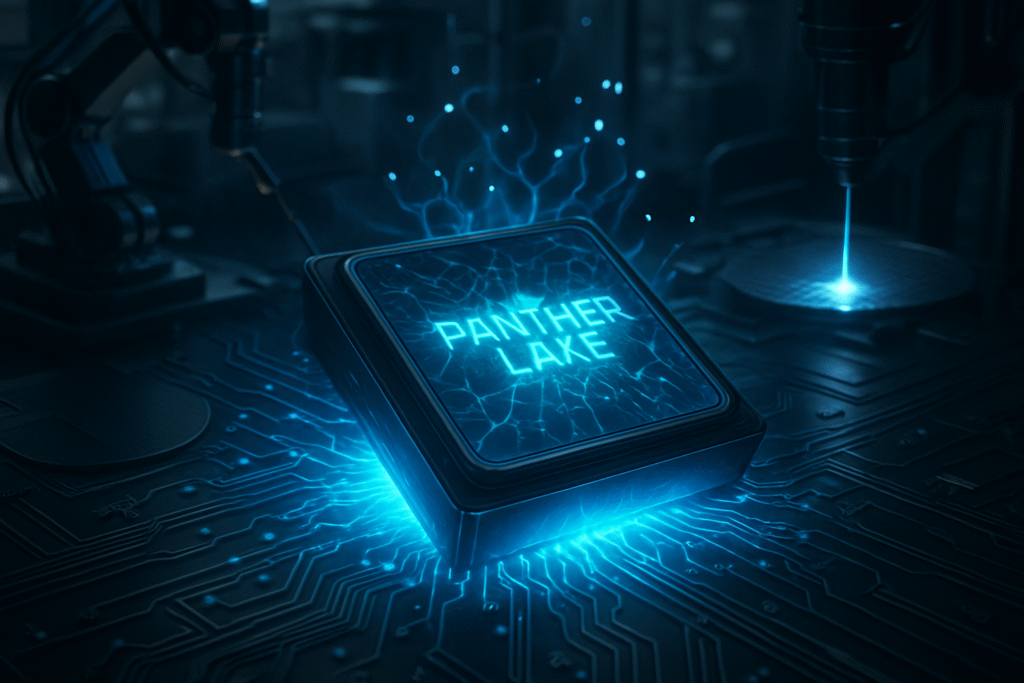
In a bold move to reclaim its semiconductor crown, Intel Corporation (NASDAQ: INTC) is gearing up for the launch of its "Panther Lake" AI chips, a cornerstone of its ambitious IDM 2.0 strategy. These next-generation processors, set to debut on the cutting-edge Intel 18A manufacturing process, are poised to redefine the AI PC landscape and serve as a crucial test of the company's multi-billion-dollar investment in advanced manufacturing, including the state-of-the-art Fab 52 facility in Chandler, Arizona. However, this aggressive push isn't without its detractors, with Arm Holdings plc (NASDAQ: ARM) CEO Rene Haas expressing significant skepticism regarding Intel's ability to overcome its past missteps and the inherent challenges of its vertically integrated model.
The impending arrival of Panther Lake marks a pivotal moment, signaling Intel's determined effort to reassert itself as a leader in silicon innovation, particularly in the rapidly expanding domain of artificial intelligence. With the first SKUs expected to ship before the end of 2025 and broad market availability slated for January 2026, Intel is betting big on these chips to power the next generation of AI-capable personal computers, directly challenging rivals and addressing the escalating demand for on-device AI processing.
Unpacking the Technical Prowess of Panther Lake
Intel's "Panther Lake" processors, branded as the Core Ultra Series 3, represent a significant leap forward, being the company's inaugural client system-on-chip (SoC) built on the advanced Intel 18A manufacturing process. This 2-nanometer-class node is a cornerstone of Intel's "five nodes in four years" strategy, incorporating groundbreaking technologies such as RibbonFET (gate-all-around transistors) for enhanced gate control and PowerVia (backside power delivery) to improve power efficiency and signal integrity. This marks a fundamental departure from previous Intel processes, aiming for a significant lead in transistor technology.
The chips boast a scalable multi-chiplet architecture, integrating new Cougar Cove Performance-cores (P-cores) and Darkmont Efficient-cores (E-cores), alongside Low-Power Efficient cores. This modular design offers unparalleled flexibility for PC manufacturers across various form factors and price points. Crucially for the AI era, Panther Lake integrates an updated neural processing unit (NPU5) capable of delivering 50 TOPS (trillions of operations per second) of AI compute. When combined with the CPU and GPU, the platform achieves up to 180 platform TOPS, significantly exceeding Microsoft Corporation's (NASDAQ: MSFT) 40 TOPS requirement for Copilot+ PCs and positioning it as a robust solution for demanding on-device AI tasks.
Intel claims substantial performance and efficiency gains over its predecessors. Early benchmarks suggest more than 50% faster CPU and graphics performance compared to the previous generation (Lunar Lake) at similar power levels. Furthermore, Panther Lake is expected to draw approximately 30% less power than Arrow Lake in multi-threaded workloads while offering comparable performance, and about 10% higher single-threaded performance than Lunar Lake at similar power draws. The integrated Arc Xe3 graphics architecture also promises over 50% faster graphics performance, complemented by support for faster memory speeds, including LPDDR5x up to 9600 MT/s and DDR5 up to 7200 MT/s, and pioneering support for Samsung's LPCAMM DRAM module.
Reshaping the AI and Competitive Landscape
The introduction of Panther Lake and Intel's broader IDM 2.0 strategy has profound implications for AI companies, tech giants, and startups alike. Companies like Dell Technologies Inc. (NYSE: DELL), HP Inc. (NYSE: HPQ), and Lenovo Group Limited (HKG: 0992) stand to benefit from Intel's renewed focus on high-performance, AI-capable client processors, enabling them to deliver next-generation AI PCs that meet the escalating demands of generative AI applications directly on the device.
Competitively, Panther Lake intensifies the battle for AI silicon dominance. Intel is directly challenging Arm-based solutions, particularly those from Qualcomm Incorporated (NASDAQ: QCOM) and Apple Inc. (NASDAQ: AAPL), which have demonstrated strong performance and efficiency in the PC market. While Nvidia Corporation (NASDAQ: NVDA) remains the leader in high-end data center AI training, Intel's push into on-device AI for PCs and its Gaudi AI accelerators for data centers aim to carve out significant market share across the AI spectrum. Intel Foundry Services (IFS) also positions the company as a direct competitor to Taiwan Semiconductor Manufacturing Company Limited (NYSE: TSM) and Samsung Electronics Co., Ltd. (KRX: 005930), offering a "systems foundry" approach that could disrupt existing supply chains and provide an alternative for companies seeking advanced manufacturing capabilities.
The potential disruption extends to existing products and services by accelerating the shift towards AI-centric computing. With powerful NPUs embedded directly into client CPUs, more AI tasks can be performed locally, reducing reliance on cloud infrastructure for certain workloads. This could lead to new software innovations leveraging on-device AI, creating opportunities for startups developing localized AI applications. Intel's market positioning, driven by its IDM 2.0 strategy, aims to re-establish its strategic advantage through process leadership and a comprehensive foundry offering, making it a critical player not just in designing chips, but in manufacturing them for others as well.
Wider Significance in the AI Ecosystem
Intel's aggressive comeback, spearheaded by Panther Lake and significant manufacturing investments like the Arizona fab, fits squarely into the broader AI landscape and trends towards ubiquitous intelligence. The ability to perform complex AI tasks at the edge, directly on personal devices, is crucial for privacy, latency, and reducing the computational burden on cloud data centers. Panther Lake's high TOPS capability for on-device AI positions it as a key enabler for this decentralized AI paradigm, fostering richer user experiences and new application categories.
The impacts extend beyond silicon. Intel's $100 billion commitment to expand domestic operations, including the Fab 52 facility in Chandler, Arizona, is a strategic move to strengthen U.S. technology and manufacturing leadership. This investment, bolstered by up to $8.9 billion in funding from the U.S. government through the CHIPS Act, is vital for diversifying the global chip supply chain and reducing reliance on overseas foundries, a critical national security concern. The operationalization of Fab 52 in 2024 for Intel 18A production is a tangible result of this effort.
However, potential concerns linger, notably articulated by Arm CEO Rene Haas. Haas's skepticism highlights Intel's past missteps in the mobile market and its delayed adoption of EUV lithography, which allowed rivals like TSMC to gain a significant lead. He questions the long-term viability and immense costs associated with Intel's vertically integrated IDM 2.0 strategy, suggesting that catching up in advanced manufacturing is an "exceedingly difficult" task due to compounding disadvantages and long industry cycles. His remarks underscore the formidable challenge Intel faces in regaining process leadership and attracting external foundry customers amidst established giants.
Charting Future Developments
Looking ahead, the successful ramp-up of Intel 18A production at the Arizona fab and the broad market availability of Panther Lake in early 2026 will be critical near-term developments. Intel's ability to consistently deliver on its "five nodes in four years" roadmap and attract major external clients to Intel Foundry Services will dictate its long-term success. The company is also expected to continue refining its Gaudi AI accelerators and Xeon CPUs for data center AI workloads, ensuring a comprehensive AI silicon portfolio.
Potential applications and use cases on the horizon include more powerful and efficient AI PCs capable of running complex generative AI models locally, enabling advanced content creation, real-time language translation, and personalized digital assistants without constant cloud connectivity. In the enterprise, Panther Lake's architecture could drive more intelligent edge devices and embedded AI solutions. Challenges that need to be addressed include sustaining process technology leadership against fierce competition, expanding the IFS customer base beyond initial commitments, and navigating the evolving software ecosystem for on-device AI to maximize hardware utilization.
Experts predict a continued fierce battle for AI silicon dominance. While Intel is making significant strides, Arm's pervasive architecture across mobile and its growing presence in servers and PCs, coupled with its ecosystem of partners, ensures intense competition. The coming months will reveal how well Panther Lake performs in real-world scenarios and how effectively Intel can execute its ambitious manufacturing and foundry strategy.
A Critical Juncture for Intel and the AI Industry
Intel's "Panther Lake" AI chips represent more than just a new product launch; they embody a high-stakes gamble on the company's future and its determination to re-establish itself as a technology leader. The key takeaways are clear: Intel is committing monumental resources to reclaim process leadership with Intel 18A, Panther Lake is designed to be a formidable player in the AI PC market, and the IDM 2.0 strategy, including the Arizona fab, is central to diversifying the global semiconductor supply chain.
This development holds immense significance in AI history, marking a critical juncture where a legacy chip giant is attempting to pivot and innovate at an unprecedented pace. If successful, Intel's efforts could reshape the AI hardware landscape, offering a strong alternative to existing solutions and fostering a more competitive environment. However, the skepticism voiced by Arm's CEO highlights the immense challenges and the unforgiving nature of the semiconductor industry.
In the coming weeks and months, all eyes will be on the performance benchmarks of Panther Lake, the progress of Intel 18A production, and the announcements of new Intel Foundry Services customers. The success or failure of this ambitious comeback will not only determine Intel's trajectory but also profoundly influence the future of AI computing from the edge to the cloud.
This content is intended for informational purposes only and represents analysis of current AI developments.
TokenRing AI delivers enterprise-grade solutions for multi-agent AI workflow orchestration, AI-powered development tools, and seamless remote collaboration platforms.
For more information, visit https://www.tokenring.ai/.





